warning FIAT 124 SPIDER 2021 Owner handbook (in English)
[x] Cancel search | Manufacturer: FIAT, Model Year: 2021, Model line: 124 SPIDER, Model: FIAT 124 SPIDER 2021Pages: 228, PDF Size: 5.08 MB
Page 81 of 228
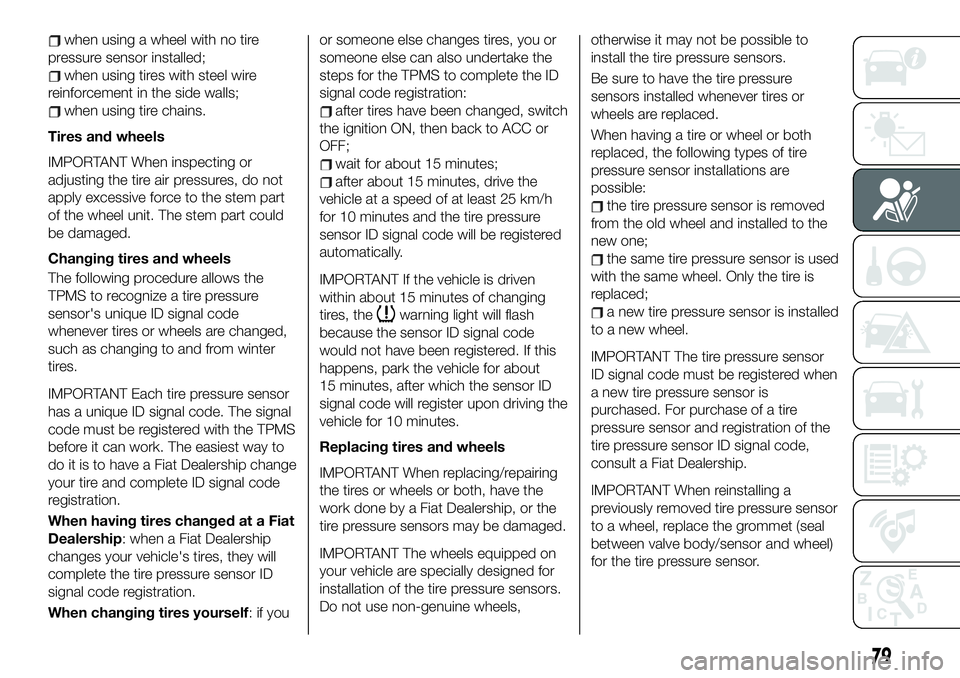
when using a wheel with no tire
pressure sensor installed;
when using tires with steel wire
reinforcement in the side walls;
when using tire chains.
Tires and wheels
IMPORTANT When inspecting or
adjusting the tire air pressures, do not
apply excessive force to the stem part
of the wheel unit. The stem part could
be damaged.
Changing tires and wheels
The following procedure allows the
TPMS to recognize a tire pressure
sensor's unique ID signal code
whenever tires or wheels are changed,
such as changing to and from winter
tires.
IMPORTANT Each tire pressure sensor
has a unique ID signal code. The signal
code must be registered with the TPMS
before it can work. The easiest way to
do it is to have a Fiat Dealership change
your tire and complete ID signal code
registration.
When having tires changed at a Fiat
Dealership: when a Fiat Dealership
changes your vehicle's tires, they will
complete the tire pressure sensor ID
signal code registration.
When changing tires yourself:ifyouor someone else changes tires, you or
someone else can also undertake the
steps for the TPMS to complete the ID
signal code registration:
after tires have been changed, switch
the ignition ON, then back to ACC or
OFF;
wait for about 15 minutes;
after about 15 minutes, drive the
vehicle at a speed of at least 25 km/h
for 10 minutes and the tire pressure
sensor ID signal code will be registered
automatically.
IMPORTANT If the vehicle is driven
within about 15 minutes of changing
tires, the
warning light will flash
because the sensor ID signal code
would not have been registered. If this
happens, park the vehicle for about
15 minutes, after which the sensor ID
signal code will register upon driving the
vehicle for 10 minutes.
Replacing tires and wheels
IMPORTANT When replacing/repairing
the tires or wheels or both, have the
work done by a Fiat Dealership, or the
tire pressure sensors may be damaged.
IMPORTANT The wheels equipped on
your vehicle are specially designed for
installation of the tire pressure sensors.
Do not use non-genuine wheels,otherwise it may not be possible to
install the tire pressure sensors.
Be sure to have the tire pressure
sensors installed whenever tires or
wheels are replaced.
When having a tire or wheel or both
replaced, the following types of tire
pressure sensor installations are
possible:
the tire pressure sensor is removed
from the old wheel and installed to the
new one;
the same tire pressure sensor is used
with the same wheel. Only the tire is
replaced;
a new tire pressure sensor is installed
to a new wheel.
IMPORTANT The tire pressure sensor
ID signal code must be registered when
a new tire pressure sensor is
purchased. For purchase of a tire
pressure sensor and registration of the
tire pressure sensor ID signal code,
consult a Fiat Dealership.
IMPORTANT When reinstalling a
previously removed tire pressure sensor
to a wheel, replace the grommet (seal
between valve body/sensor and wheel)
for the tire pressure sensor.
79
Page 82 of 228
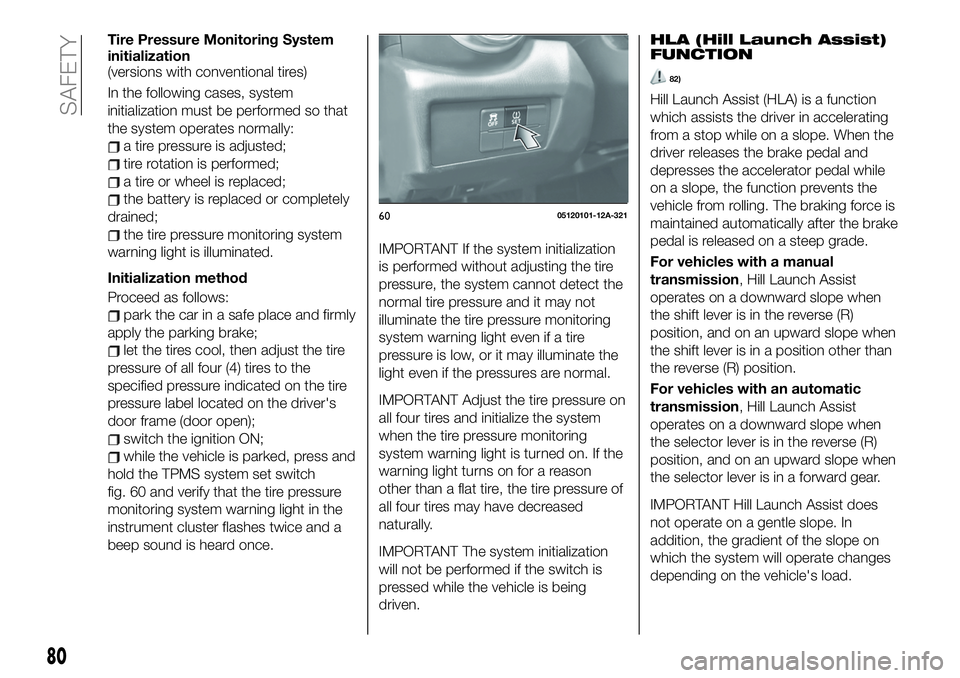
Tire Pressure Monitoring System
initialization
(versions with conventional tires)
In the following cases, system
initialization must be performed so that
the system operates normally:
a tire pressure is adjusted;
tire rotation is performed;
a tire or wheel is replaced;
the battery is replaced or completely
drained;
the tire pressure monitoring system
warning light is illuminated.
Initialization method
Proceed as follows:
park the car in a safe place and firmly
apply the parking brake;
let the tires cool, then adjust the tire
pressure of all four (4) tires to the
specified pressure indicated on the tire
pressure label located on the driver's
door frame (door open);
switch the ignition ON;
while the vehicle is parked, press and
hold the TPMS system set switch
fig. 60 and verify that the tire pressure
monitoring system warning light in the
instrument cluster flashes twice and a
beep sound is heard once.
IMPORTANT If the system initialization
is performed without adjusting the tire
pressure, the system cannot detect the
normal tire pressure and it may not
illuminate the tire pressure monitoring
system warning light even if a tire
pressure is low, or it may illuminate the
light even if the pressures are normal.
IMPORTANT Adjust the tire pressure on
all four tires and initialize the system
when the tire pressure monitoring
system warning light is turned on. If the
warning light turns on for a reason
other than a flat tire, the tire pressure of
all four tires may have decreased
naturally.
IMPORTANT The system initialization
will not be performed if the switch is
pressed while the vehicle is being
driven.HLA (Hill Launch Assist)
FUNCTION
82)
Hill Launch Assist (HLA) is a function
which assists the driver in accelerating
from a stop while on a slope. When the
driver releases the brake pedal and
depresses the accelerator pedal while
on a slope, the function prevents the
vehicle from rolling. The braking force is
maintained automatically after the brake
pedal is released on a steep grade.
For vehicles with a manual
transmission, Hill Launch Assist
operates on a downward slope when
the shift lever is in the reverse (R)
position, and on an upward slope when
the shift lever is in a position other than
the reverse (R) position.
For vehicles with an automatic
transmission, Hill Launch Assist
operates on a downward slope when
the selector lever is in the reverse (R)
position, and on an upward slope when
the selector lever is in a forward gear.
IMPORTANT Hill Launch Assist does
not operate on a gentle slope. In
addition, the gradient of the slope on
which the system will operate changes
depending on the vehicle's load.
6005120101-12A-321
80
SAFETY
Page 83 of 228
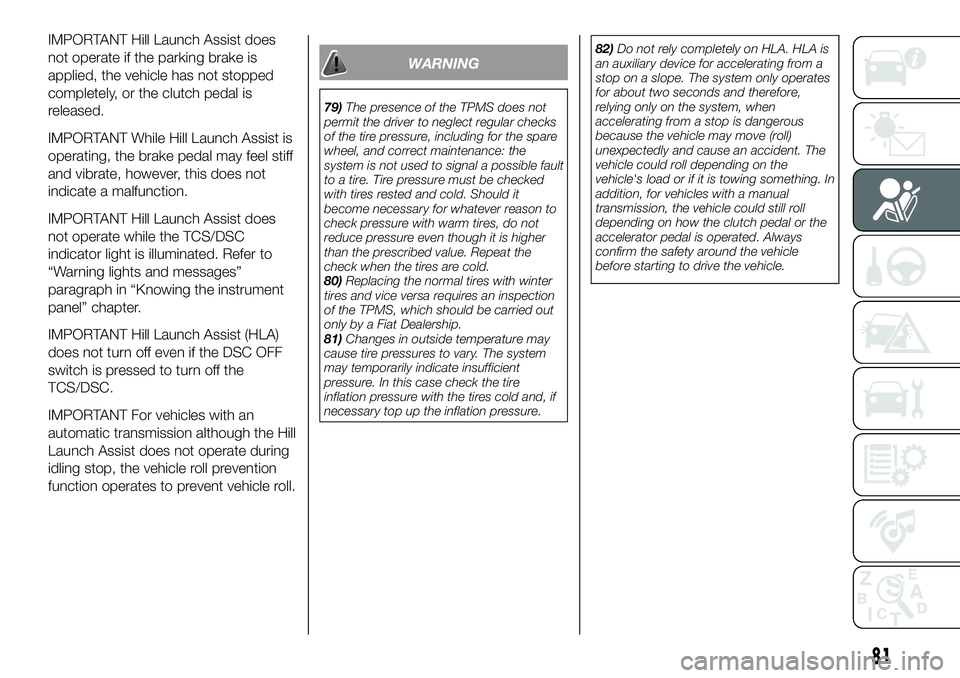
IMPORTANT Hill Launch Assist does
not operate if the parking brake is
applied, the vehicle has not stopped
completely, or the clutch pedal is
released.
IMPORTANT While Hill Launch Assist is
operating, the brake pedal may feel stiff
and vibrate, however, this does not
indicate a malfunction.
IMPORTANT Hill Launch Assist does
not operate while the TCS/DSC
indicator light is illuminated. Refer to
“Warning lights and messages”
paragraph in “Knowing the instrument
panel” chapter.
IMPORTANT Hill Launch Assist (HLA)
does not turn off even if the DSC OFF
switch is pressed to turn off the
TCS/DSC.
IMPORTANT For vehicles with an
automatic transmission although the Hill
Launch Assist does not operate during
idling stop, the vehicle roll prevention
function operates to prevent vehicle roll.
WARNING
79)The presence of the TPMS does not
permit the driver to neglect regular checks
of the tire pressure, including for the spare
wheel, and correct maintenance: the
system is not used to signal a possible fault
to a tire. Tire pressure must be checked
with tires rested and cold. Should it
become necessary for whatever reason to
check pressure with warm tires, do not
reduce pressure even though it is higher
than the prescribed value. Repeat the
check when the tires are cold.
80)Replacing the normal tires with winter
tires and vice versa requires an inspection
of the TPMS, which should be carried out
only by a Fiat Dealership.
81)Changes in outside temperature may
cause tire pressures to vary. The system
may temporarily indicate insufficient
pressure. In this case check the tire
inflation pressure with the tires cold and, if
necessary top up the inflation pressure.82)Do not rely completely on HLA. HLA is
an auxiliary device for accelerating from a
stop on a slope. The system only operates
for about two seconds and therefore,
relying only on the system, when
accelerating from a stop is dangerous
because the vehicle may move (roll)
unexpectedly and cause an accident. The
vehicle could roll depending on the
vehicle's load or if it is towing something. In
addition, for vehicles with a manual
transmission, the vehicle could still roll
depending on how the clutch pedal or the
accelerator pedal is operated. Always
confirm the safety around the vehicle
before starting to drive the vehicle.
81
Page 85 of 228
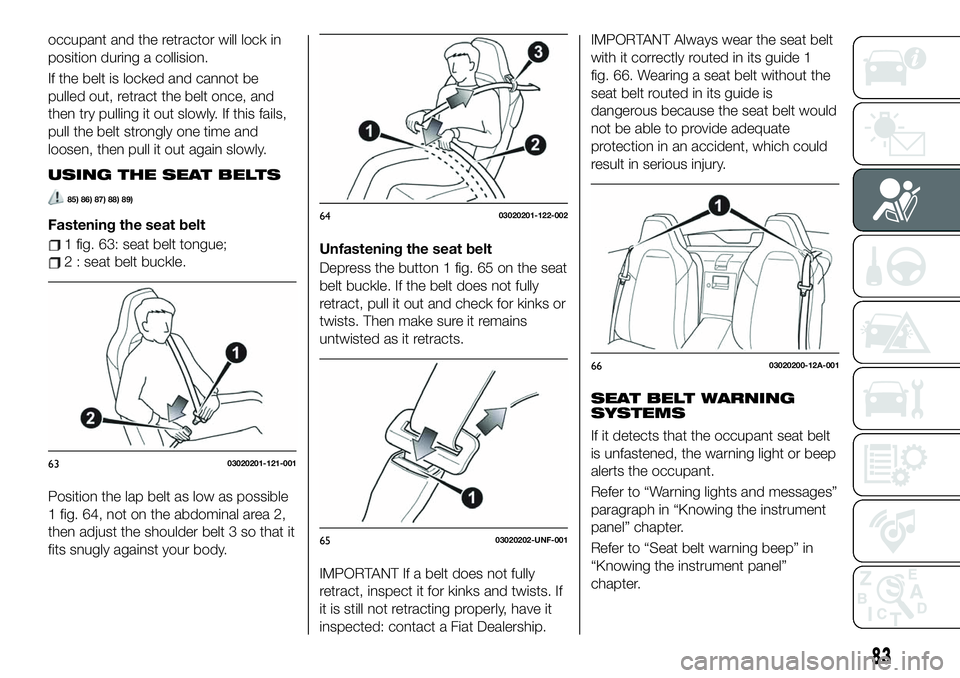
occupant and the retractor will lock in
position during a collision.
If the belt is locked and cannot be
pulled out, retract the belt once, and
then try pulling it out slowly. If this fails,
pull the belt strongly one time and
loosen, then pull it out again slowly.
USING THE SEAT BELTS
85) 86) 87) 88) 89)
Fastening the seat belt
1 fig. 63: seat belt tongue;
2 : seat belt buckle.
Position the lap belt as low as possible
1 fig. 64, not on the abdominal area 2,
then adjust the shoulder belt 3 so that it
fits snugly against your body.Unfastening the seat belt
Depress the button 1 fig. 65 on the seat
belt buckle. If the belt does not fully
retract, pull it out and check for kinks or
twists. Then make sure it remains
untwisted as it retracts.
IMPORTANT If a belt does not fully
retract, inspect it for kinks and twists. If
it is still not retracting properly, have it
inspected: contact a Fiat Dealership.IMPORTANT Always wear the seat belt
with it correctly routed in its guide 1
fig. 66. Wearing a seat belt without the
seat belt routed in its guide is
dangerous because the seat belt would
not be able to provide adequate
protection in an accident, which could
result in serious injury.
SEAT BELT WARNING
SYSTEMS
If it detects that the occupant seat belt
is unfastened, the warning light or beep
alerts the occupant.
Refer to “Warning lights and messages”
paragraph in “Knowing the instrument
panel” chapter.
Refer to “Seat belt warning beep” in
“Knowing the instrument panel”
chapter.
6303020201-121-001
6403020201-122-002
6503020202-UNF-001
6603020200-12A-001
83
Page 86 of 228
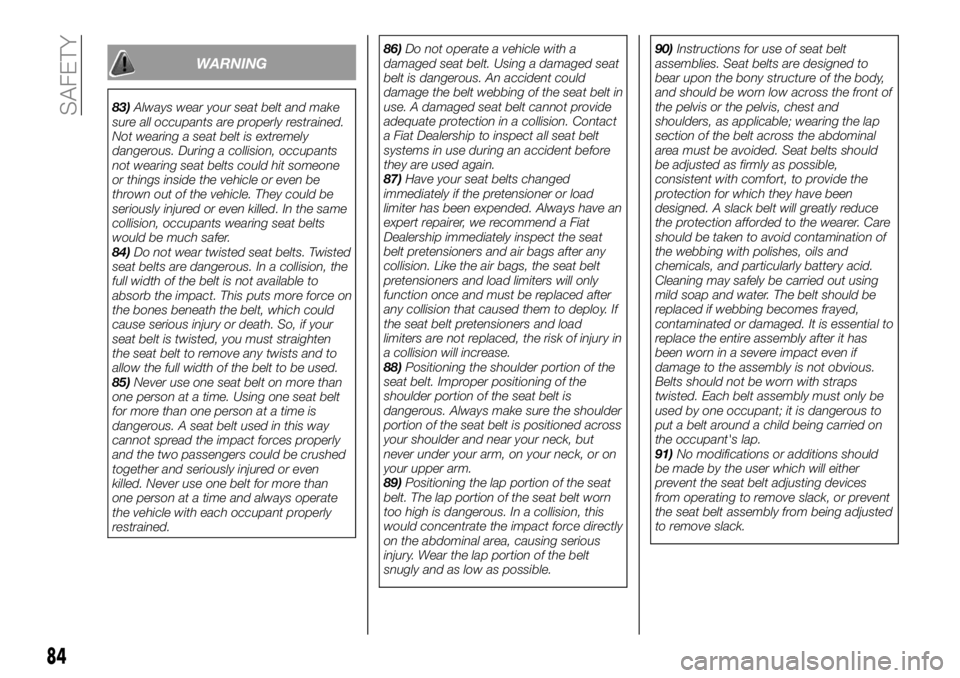
WARNING
83)Always wear your seat belt and make
sure all occupants are properly restrained.
Not wearing a seat belt is extremely
dangerous. During a collision, occupants
not wearing seat belts could hit someone
or things inside the vehicle or even be
thrown out of the vehicle. They could be
seriously injured or even killed. In the same
collision, occupants wearing seat belts
would be much safer.
84)Do not wear twisted seat belts. Twisted
seat belts are dangerous. In a collision, the
full width of the belt is not available to
absorb the impact. This puts more force on
the bones beneath the belt, which could
cause serious injury or death. So, if your
seat belt is twisted, you must straighten
the seat belt to remove any twists and to
allow the full width of the belt to be used.
85)Never use one seat belt on more than
one person at a time. Using one seat belt
for more than one person at a time is
dangerous. A seat belt used in this way
cannot spread the impact forces properly
and the two passengers could be crushed
together and seriously injured or even
killed. Never use one belt for more than
one person at a time and always operate
the vehicle with each occupant properly
restrained.86)Do not operate a vehicle with a
damaged seat belt. Using a damaged seat
belt is dangerous. An accident could
damage the belt webbing of the seat belt in
use. A damaged seat belt cannot provide
adequate protection in a collision. Contact
a Fiat Dealership to inspect all seat belt
systems in use during an accident before
they are used again.
87)Have your seat belts changed
immediately if the pretensioner or load
limiter has been expended. Always have an
expert repairer, we recommend a Fiat
Dealership immediately inspect the seat
belt pretensioners and air bags after any
collision. Like the air bags, the seat belt
pretensioners and load limiters will only
function once and must be replaced after
any collision that caused them to deploy. If
the seat belt pretensioners and load
limiters are not replaced, the risk of injury in
a collision will increase.
88)Positioning the shoulder portion of the
seat belt. Improper positioning of the
shoulder portion of the seat belt is
dangerous. Always make sure the shoulder
portion of the seat belt is positioned across
your shoulder and near your neck, but
never under your arm, on your neck, or on
your upper arm.
89)Positioning the lap portion of the seat
belt. The lap portion of the seat belt worn
too high is dangerous. In a collision, this
would concentrate the impact force directly
on the abdominal area, causing serious
injury. Wear the lap portion of the belt
snugly and as low as possible.90)Instructions for use of seat belt
assemblies. Seat belts are designed to
bear upon the bony structure of the body,
and should be worn low across the front of
the pelvis or the pelvis, chest and
shoulders, as applicable; wearing the lap
section of the belt across the abdominal
area must be avoided. Seat belts should
be adjusted as firmly as possible,
consistent with comfort, to provide the
protection for which they have been
designed. A slack belt will greatly reduce
the protection afforded to the wearer. Care
should be taken to avoid contamination of
the webbing with polishes, oils and
chemicals, and particularly battery acid.
Cleaning may safely be carried out using
mild soap and water. The belt should be
replaced if webbing becomes frayed,
contaminated or damaged. It is essential to
replace the entire assembly after it has
been worn in a severe impact even if
damage to the assembly is not obvious.
Belts should not be worn with straps
twisted. Each belt assembly must only be
used by one occupant; it is dangerous to
put a belt around a child being carried on
the occupant's lap.
91)No modifications or additions should
be made by the user which will either
prevent the seat belt adjusting devices
from operating to remove slack, or prevent
the seat belt assembly from being adjusted
to remove slack.
84
SAFETY
Page 87 of 228
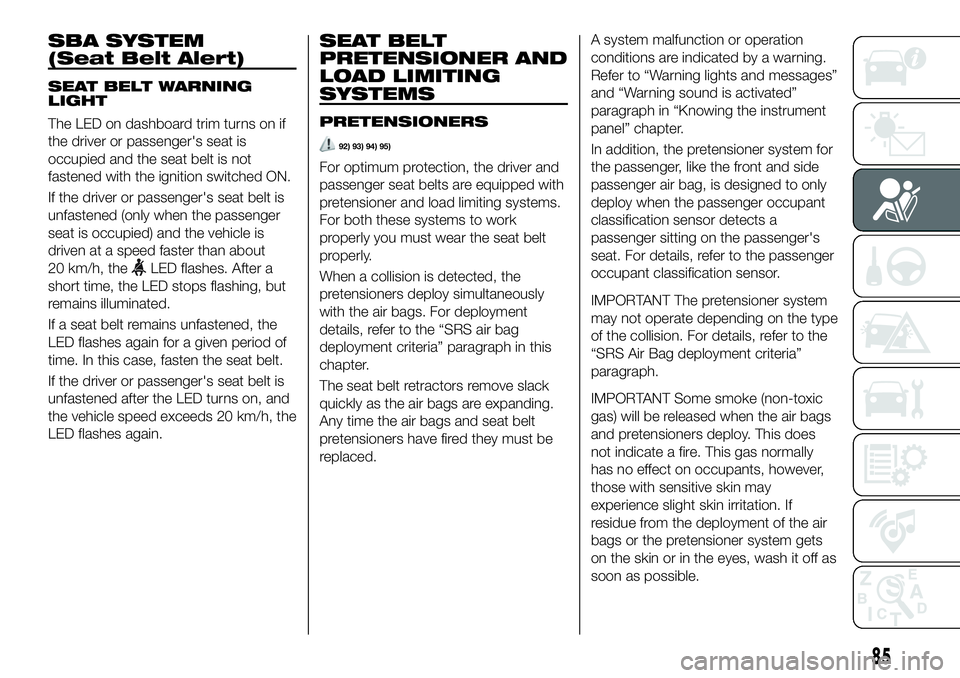
SBA SYSTEM
(Seat Belt Alert)
SEAT BELT WARNING
LIGHT
The LED on dashboard trim turns on if
the driver or passenger's seat is
occupied and the seat belt is not
fastened with the ignition switched ON.
If the driver or passenger's seat belt is
unfastened (only when the passenger
seat is occupied) and the vehicle is
driven at a speed faster than about
20 km/h, the
LED flashes. After a
short time, the LED stops flashing, but
remains illuminated.
If a seat belt remains unfastened, the
LED flashes again for a given period of
time. In this case, fasten the seat belt.
If the driver or passenger's seat belt is
unfastened after the LED turns on, and
the vehicle speed exceeds 20 km/h, the
LED flashes again.
SEAT BELT
PRETENSIONER AND
LOAD LIMITING
SYSTEMS
PRETENSIONERS
92) 93) 94) 95)
For optimum protection, the driver and
passenger seat belts are equipped with
pretensioner and load limiting systems.
For both these systems to work
properly you must wear the seat belt
properly.
When a collision is detected, the
pretensioners deploy simultaneously
with the air bags. For deployment
details, refer to the “SRS air bag
deployment criteria” paragraph in this
chapter.
The seat belt retractors remove slack
quickly as the air bags are expanding.
Any time the air bags and seat belt
pretensioners have fired they must be
replaced.A system malfunction or operation
conditions are indicated by a warning.
Refer to “Warning lights and messages”
and “Warning sound is activated”
paragraph in “Knowing the instrument
panel” chapter.
In addition, the pretensioner system for
the passenger, like the front and side
passenger air bag, is designed to only
deploy when the passenger occupant
classification sensor detects a
passenger sitting on the passenger's
seat. For details, refer to the passenger
occupant classification sensor.
IMPORTANT The pretensioner system
may not operate depending on the type
of the collision. For details, refer to the
“SRS Air Bag deployment criteria”
paragraph.
IMPORTANT Some smoke (non-toxic
gas) will be released when the air bags
and pretensioners deploy. This does
not indicate a fire. This gas normally
has no effect on occupants, however,
those with sensitive skin may
experience slight skin irritation. If
residue from the deployment of the air
bags or the pretensioner system gets
on the skin or in the eyes, wash it off as
soon as possible.
85
Page 88 of 228

LOAD LIMITER
The load limiting system releases belt
webbing in a controlled manner to
reduce belt force on the occupant's
chest.
While the most severe load on a seat
belt occurs in frontal collisions, the load
limiter has an automatic mechanical
function and can activate in any
accident mode with sufficient occupant
movement.
Even if the pretensioners have not fired,
the load limiting function must be
checked by Fiat Dealership.
WARNING
92)Wear seat belts only as recommended
in this Owner Handbook. Incorrect
positioning of the driver and passenger
seat belts is dangerous. Without proper
positioning, the pretensioner and load
limiting systems cannot provide adequate
protection in an accident and this could
result in serious injury. For more details
about wearing seat belts, refer to
"Fastening the seat belts".93)Have your seat belts changed
immediately if the pretensioner or load
limiter has been expended. Always have an
expert repairer: contact a Fiat Dealership
immediately for seat belt pretensioners and
air bags inspections after any collision. Like
the air bags, the seat belt pretensioners
and load limiters will only function once and
must be replaced after any collision that
caused them to deploy. If the seat belt
pretensioners and load limiters are not
replaced, the risk of injury in a collision will
increase.
94)Do not modify the components or
wiring, or use electronic testing devices on
the pretensioner system. Modifying the
components or wiring of the pretensioner
system, including the use of electronic
testing devices is dangerous. You could
accidentally activate it or make it inoperable
which would prevent it from activating in an
accident. The occupants or repairers could
be seriously injured.
95)Properly dispose of the pretensioner
system. Improper disposal of the
pretensioner system or a vehicle with non
deactivated pretensioners is dangerous.
Unless all safety procedures are followed,
injury could result. Contact a Fiat
Dealership for safely dispose of the
pretensioner system or scrap a
pretensioner system equipped vehicle.
CHILD-RESTRAINT
PRECAUTIONS
96) 98) 99) 100) 101) 102) 103) 104) 105) 106)
FCA strongly urges the use of
child-restraint systems for children small
enough to use them.
FCA recommends use of a genuine
child-restraint system or one that
complies with the UNECE 44 (*)
regulation. If you would like to purchase
a FCA genuine child-restraint system,
please contact a Fiat Dealership.
Check your local and state or provincial
laws for specific requirements regarding
the safety of children riding in your
vehicle.
(*) UNECE stands for United Nations
Economic Commission for Europe.
Whatever child-restraint system you
consider, please pick the appropriate
one for the age and size of the child,
obey the law and follow the instructions
that come with the individual
child-restraint system.
86
SAFETY
Page 98 of 228
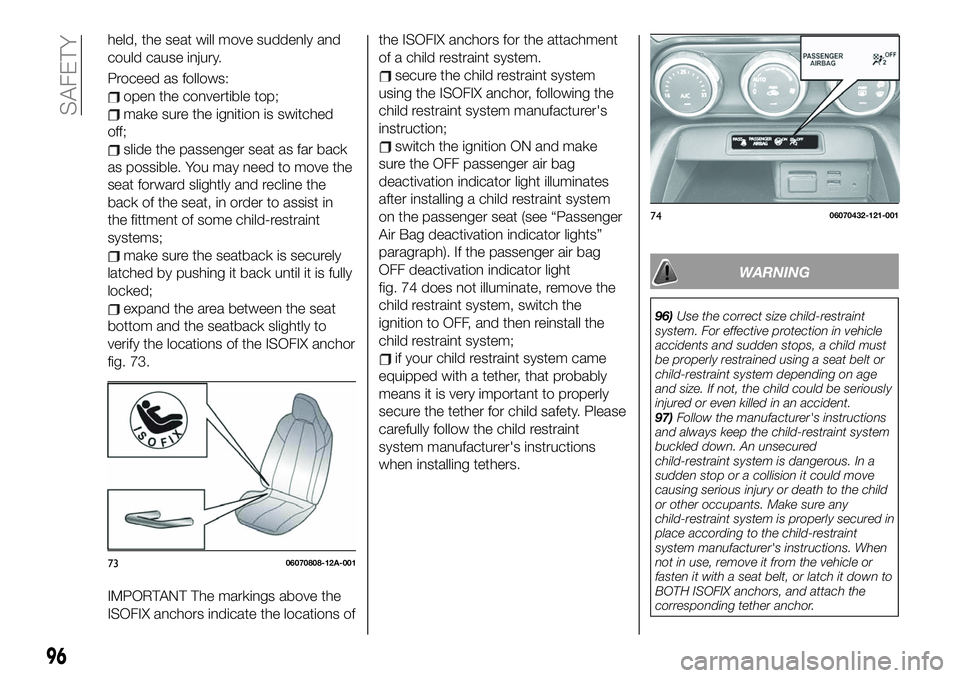
held, the seat will move suddenly and
could cause injury.
Proceed as follows:
open the convertible top;
make sure the ignition is switched
off;
slide the passenger seat as far back
as possible. You may need to move the
seat forward slightly and recline the
back of the seat, in order to assist in
the fittment of some child-restraint
systems;
make sure the seatback is securely
latched by pushing it back until it is fully
locked;
expand the area between the seat
bottom and the seatback slightly to
verify the locations of the ISOFIX anchor
fig. 73.
IMPORTANT The markings above the
ISOFIX anchors indicate the locations ofthe ISOFIX anchors for the attachment
of a child restraint system.
secure the child restraint system
using the ISOFIX anchor, following the
child restraint system manufacturer's
instruction;
switch the ignition ON and make
sure the OFF passenger air bag
deactivation indicator light illuminates
after installing a child restraint system
on the passenger seat (see “Passenger
Air Bag deactivation indicator lights”
paragraph). If the passenger air bag
OFF deactivation indicator light
fig. 74 does not illuminate, remove the
child restraint system, switch the
ignition to OFF, and then reinstall the
child restraint system;
if your child restraint system came
equipped with a tether, that probably
means it is very important to properly
secure the tether for child safety. Please
carefully follow the child restraint
system manufacturer's instructions
when installing tethers.
WARNING
96)Use the correct size child-restraint
system. For effective protection in vehicle
accidents and sudden stops, a child must
be properly restrained using a seat belt or
child-restraint system depending on age
and size. If not, the child could be seriously
injured or even killed in an accident.
97)Follow the manufacturer's instructions
and always keep the child-restraint system
buckled down. An unsecured
child-restraint system is dangerous. In a
sudden stop or a collision it could move
causing serious injury or death to the child
or other occupants. Make sure any
child-restraint system is properly secured in
place according to the child-restraint
system manufacturer's instructions. When
not in use, remove it from the vehicle or
fasten it with a seat belt, or latch it down to
BOTH ISOFIX anchors, and attach the
corresponding tether anchor.
7306070808-12A-001
7406070432-121-001
96
SAFETY
Page 99 of 228
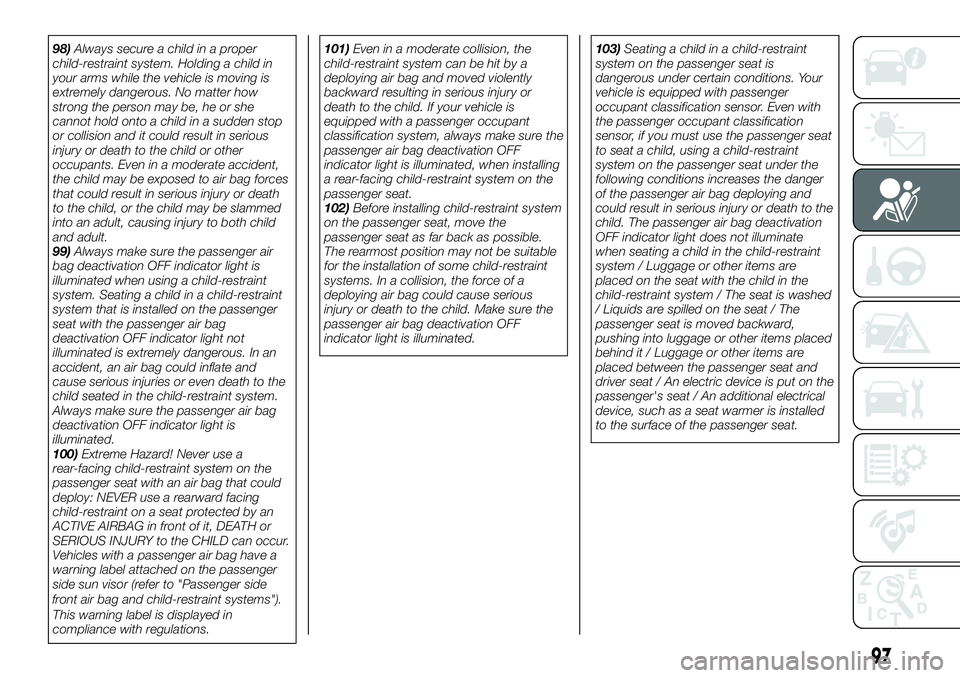
98)Always secure a child in a proper
child-restraint system. Holding a child in
your arms while the vehicle is moving is
extremely dangerous. No matter how
strong the person may be, he or she
cannot hold onto a child in a sudden stop
or collision and it could result in serious
injury or death to the child or other
occupants. Even in a moderate accident,
the child may be exposed to air bag forces
that could result in serious injury or death
to the child, or the child may be slammed
into an adult, causing injury to both child
and adult.
99)Always make sure the passenger air
bag deactivation OFF indicator light is
illuminated when using a child-restraint
system. Seating a child in a child-restraint
system that is installed on the passenger
seat with the passenger air bag
deactivation OFF indicator light not
illuminated is extremely dangerous. In an
accident, an air bag could inflate and
cause serious injuries or even death to the
child seated in the child-restraint system.
Always make sure the passenger air bag
deactivation OFF indicator light is
illuminated.
100)Extreme Hazard! Never use a
rear-facing child-restraint system on the
passenger seat with an air bag that could
deploy: NEVER use a rearward facing
child-restraint on a seat protected by an
ACTIVE AIRBAG in front of it, DEATH or
SERIOUS INJURY to the CHILD can occur.
Vehicles with a passenger air bag have a
warning label attached on the passenger
This warning label is displayed in
compliance with regulations.101)Even in a moderate collision, the
child-restraint system can be hit by a
deploying air bag and moved violently
backward resulting in serious injury or
death to the child. If your vehicle is
equipped with a passenger occupant
classification system, always make sure the
passenger air bag deactivation OFF
indicator light is illuminated, when installing
a rear-facing child-restraint system on the
passenger seat.
102)Before installing child-restraint system
on the passenger seat, move the
passenger seat as far back as possible.
The rearmost position may not be suitable
for the installation of some child-restraint
systems. In a collision, the force of a
deploying air bag could cause serious
injury or death to the child. Make sure the
passenger air bag deactivation OFF
indicator light is illuminated.103)Seating a child in a child-restraint
system on the passenger seat is
dangerous under certain conditions. Your
vehicle is equipped with passenger
occupant classification sensor. Even with
the passenger occupant classification
sensor, if you must use the passenger seat
to seat a child, using a child-restraint
system on the passenger seat under the
following conditions increases the danger
of the passenger air bag deploying and
could result in serious injury or death to the
child. The passenger air bag deactivation
OFF indicator light does not illuminate
when seating a child in the child-restraint
system / Luggage or other items are
placed on the seat with the child in the
child-restraint system / The seat is washed
/ Liquids are spilled on the seat / The
passenger seat is moved backward,
pushing into luggage or other items placed
behind it / Luggage or other items are
placed between the passenger seat and
driver seat / An electric device is put on the
passenger's seat / An additional electrical
device, such as a seat warmer is installed
to the surface of the passenger seat.
97
side sun visor (refer to "Passenger side
front air bag and child-restraint systems").
Page 103 of 228
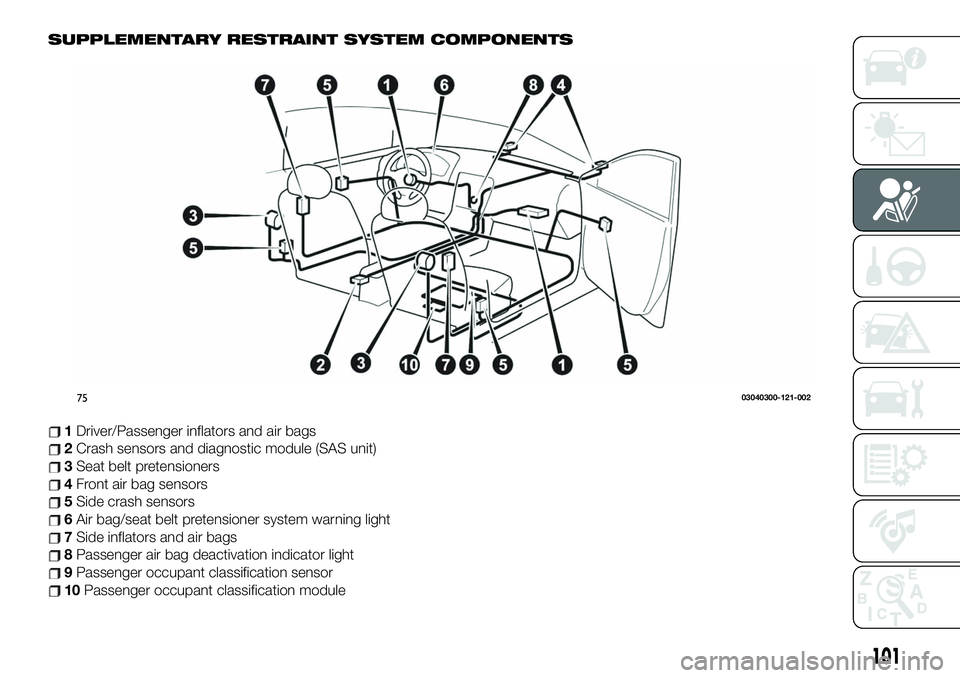
SUPPLEMENTARY RESTRAINT SYSTEM COMPONENTS
1Driver/Passenger inflators and air bags
2Crash sensors and diagnostic module (SAS unit)
3Seat belt pretensioners
4Front air bag sensors
5Side crash sensors
6Air bag/seat belt pretensioner system warning light
7Side inflators and air bags
8Passenger air bag deactivation indicator light
9Passenger occupant classification sensor
10Passenger occupant classification module
7503040300-121-002
101